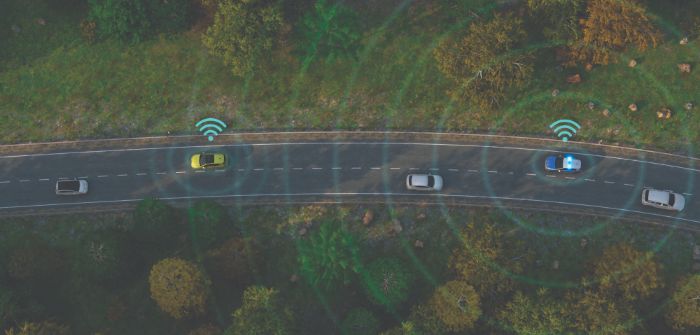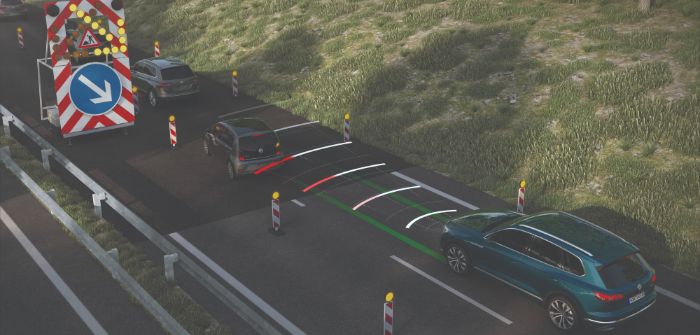With the arrival of the eighth-generation Golf, Volkswagen is the first manufacturer to bring V2X technology to the mass market. ATTI delves into VW’s extensive development and testing process and discovers how it can benefit autonomous driving functions.
The CAR 2 CAR Communication Consortium (C2C-CC) was established in Europe in 2002 by vehicle manufacturers to investigate, test and implement V2V and vehicle-to-everything (V2X) technology, and Volkswagen is the first out of the blocks to bring the first so-equipped production car to market.
The eighth-generation Golf has taken the model’s biggest technological leap in its 46-year history. One of Golf 8’s most important developments is the arrival of digital technology, not only in its pared-back cabin appearance, but also as a crucial part of the car’s onboard systems. An online connectivity unit (OCU) with integrated eSIM not only means that those systems are networked to each other, but also to the outside world. Particularly relevant to V2V, the new Golf is the first Volkswagen to be fully networked to
its surroundings via the company’s Car2X technology.
Data drive
Based on the wifi-p/WLANp wireless standard (also known as IEEE 802.11p and ITS-G5), positioning data and information from other vehicles and traffic infrastructure within a radius of 800m (2,625ft) is collected to warn drivers of any incidents and then forwarded to other Car2X-equipped vehicles within milliseconds. Related to wi-fi, wifi-p is designed to exchange data on the 5.9GHz band between vehicles and smart infrastructure.
“This type of wi-fi is specifically tailored to local communication between vehicles and does not use the mobile phone network, which means it provides blanket coverage within the limits of the system,” says Dr Hendrik-Jörn Günther, Volkswagen Passenger Cars’ senior connected vehicle engineer. “Car2X technology
can warn the driver of problems such as roadside breakdowns, the tail end of a traffic jam, or the location of an accident. It is also a benefit in emergency braking situations. If a driver suddenly operates the brakes or an automatic braking system is triggered – which can prompt the car’s brake lights before the brakes are physically applied – this affects traffic behind. With Car2X, other vehicles are informed of sudden braking maneuvers by traffic participants, enabling drivers to slow down in good time,” he says.
It may also be a lifesaver. In 2016, the US National Highway Traffic Safety Administration stated that there could be 439,000 fewer accidents if vehicles were fitted with V2V technology. In Europe, Euro NCAP intends to incorporate Car2X functions into its safety ratings.
There are other benefits in addition to accident prevention. “The system can warn drivers of stationary hazards such as road works,” explains Günther.

“Car2X information could also be employed by receiving traffic light information, which can help infrastructure and road operators to increase traffic efficiency.” The location of emergency vehicles can also be determined, enabling traffic to react more quickly to create a safe passage.
The real world
Extensive testing of Car2X technology in real-world environments is essential. A joint project in VW’s home city of Wolfsburg with Siemens – the two companies are supporters of the European Union’s objective of establishing a binding framework for networked driving across Europe – involved a total of 10 traffic signal systems that transmitted traffic light phases via wifi-p, along with two sets of crossroads fitted with sensor technology to detect pedestrians and cyclists.
It’s not just cars that benefit from the technology either. In 2019, the Volkswagen Group also undertook the world’s first pilot project for traffic optimization with a D-Wave quantum computer in Lisbon, used on a Carris bus fleet during the WebSummit technology conference. Commercial vehicle platooning on highways is another instance where Car2X could bring efficiency savings.
In January 2020, the Testfeld Niedersachsen (Lower Saxony Testing Area) cooperative project opened on the A39 autobahn in Germany. Situated between Wolfsburg and Braunschweig, a 7km (four-mile) stretch of road operated by the German Aerospace Center (DLR) collects traffic flow data.
Part-financed by the State of Lower Saxony, 71 masts with high-resolution cameras have been erected along the real-world test track. Anonymized data on the driving behavior of different types of road users
is recorded, and no data that is specific to individual vehicles – such as license plates or drivers’ faces – is collected. Only trajectories and movements of traffic are documented for evaluation.
“The main priority for us is that we are able to gather insights and data on how the traffic actually behaves, in order to draw conclusions from that for the software for autonomous and assisted driving,” says Dr Sven Klomp, Volkswagen’s project manager for the preliminary development of assistance systems.
Useful for open research and development, companies such as Continental and Siemens are also taking advantage of the A39 project. Dr Frank Welsch, chief development officer at Volkswagen Passenger Cars, believes the experiment will provide important valuations to further Car2X technology. “In order to research assisted driving, data from standard daily traffic is necessary. The Lower Saxony testing area allows us to not only collect such data in a completely real-world environment,
but also expand on it using simulations,” he says.
That real-world data will then feed back into those traffic flow simulations. “We aim to constantly update
our traffic and simulation models with information based on real-life observations,” says Günther. “This helps us to reconstruct situations and assist with feature development.”
Car2X is currently available on the new Golf only, but Günther confirms it has a place in forthcoming
VW passenger cars. “The Car2X technology facilitates ‘swarm intelligence’ in a local environment and is improving as more and more participants connect. For this reason, Volkswagen is now rolling it out on
a broad scale. After the Golf, other new models from the brand will feature it as standard.” And there are
no limits to the type of powertrain the vehicle has – the safety and efficiency improvements will benefit
all cars. “The technology was not made for a specific power unit. We believe that the benefits the system offers should be made available to all types of powertrain,” Günther comments.
Aid and assist
As well as Car2X tech, the eighth-generation Golf also heralds the arrival of innovative assisted driving functions. The Travel Assist system enables driving at up to 130mph (210km/h) without any active steering, acceleration or braking inputs, and Günther recognizes that Car2X may directly benefit the development of other intelligent AV functions. “Currently, the technology is able to help inform the driver about any events in the immediate driving environment. Future AV applications could incorporate information from other features within the limits of their systems. We believe Car2X can help possible future applications such as adaptive cruise control adjust to the presence of a traffic jam. This function would also be an example of an application relying on multiple sensor input,” he says.
While some OEMs are awaiting the arrival of 5G before they launch Car2X systems, another advantage wifi-p offers is direct communication. This aids privacy, because with no cloud service, there is no record of exchanged data. For skeptics wary of any possible data collection, however, Günther says there will be safeguards to anonymize direct links back to an individual’s identity. “When setting up an ID in the vehicle for the first time, a ‘wizard’ will run through the necessary steps. This will include, for example, providing digital consent to the privacy policy directly in the vehicle in order to be able to use Car2X. Should users decide otherwise, they can change their privacy settings via the infotainment system,” he says.
With its Car2X technology, it seems Volkswagen has every box ticked.
Total autonomy
Far from being just an automotive manufacturer, Volkswagen is transitioning to also being a software provider. Looking to boost its current in-house vehicle software development share from less than 10% to at least 60% by 2025, more than 10,000 digital experts will eventually work under the new Car.Software banner, and all Volkswagen Group vehicles are expected to run on the same software platform by the same date. A vehicle operating system – vw.os – and the Volkswagen Automotive Cloud (jointly developed with Microsoft) will also be introduced.
“We are platform professionals for hardware and are now transferring this competence to development of software,” explains Christian Senger (pictured), member of the Volkswagen Passenger Cars board of management with responsibility for the auto maker’s digital car and services.
All VW software, from the in-car operating system to digital ecosystems for new mobility services, will come under Car.Software, which will have global satellite development bases. Cross-brand software advances in five domains (automated driving, intelligent body and cockpit, connected cars and devices, digital business and mobility services, and vehicle motion and energy) will help Car.Software’s objective of establishing a uniform group software architecture that draws on parallel development paths from all brands.
As well as software, Volkswagen Autonomy (VWAT) has been established as a center of excellence for the development of self-driving systems from Level 4, with sites in Germany. Operations in both Silicon Valley and China are also planned and the division will serve as a central know-how container within the Volkswagen Group to bring self-driving services to a level of market maturity. As part of Volkswagen’s industrial cooperation with Ford announced in July 2019, it is also taking an equal stake in Argo AI, which is developing autonomous driving technologies.
By Richard Gooding



